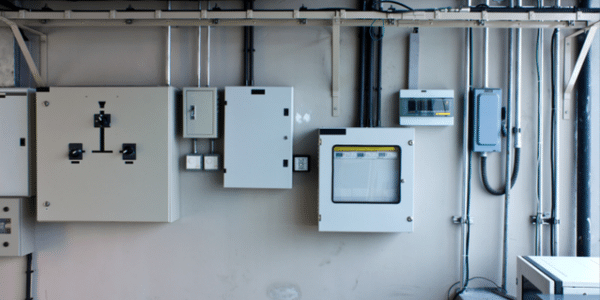Enhancing Workplace Safety with Electrical Fiberglass Boxes: Best Practices for Risk Mitigation
6/15/20244 min read


Understanding the Importance of Electrical Fiberglass Boxes
Electrical fiberglass boxes, also known as fiberglass-reinforced plastic (FRP) enclosures, are essential components in enhancing workplace safety. These boxes are made from a composite material that combines glass fibers with a resin matrix, resulting in a product that is both strong and lightweight. Primarily used to house electrical components and wiring, electrical fiberglass boxes are designed to offer superior protection from environmental hazards.
One significant advantage of electrical fiberglass boxes is their non-conductive properties. Unlike metal enclosures, which can conduct electricity and pose a risk of electrical shock, fiberglass boxes effectively insulate electrical components, minimizing the risk of accidental electrical contact. This makes them an ideal choice for environments where safety is a paramount concern.
Furthermore, electrical fiberglass boxes offer exceptional resistance to corrosion. In contrast to traditional metal boxes that may rust or degrade over time when exposed to moisture or chemicals, fiberglass enclosures maintain their integrity even in the harshest conditions. This resistance to environmental factors extends the lifespan of the enclosures, reducing the need for frequent replacements and maintenance.
Durability is another key benefit of electrical fiberglass boxes. They are engineered to withstand physical impacts and are less likely to crack or break compared to plastic enclosures. This robustness ensures that the electrical components housed within remain protected, even in challenging industrial settings.
Electrical fiberglass boxes are particularly beneficial in hazardous or corrosive environments, such as chemical plants, oil refineries, and marine applications. In these settings, the combination of their non-conductive nature, corrosion resistance, and durability makes them indispensable for safeguarding electrical systems and enhancing workplace safety. By integrating electrical fiberglass boxes into safety protocols, organizations can significantly mitigate risks associated with electrical hazards and environmental exposure.
In conclusion, the strategic implementation of electrical fiberglass boxes in various industrial settings not only optimizes safety but also contributes to the longevity and reliability of electrical systems. Their unique properties make them a superior alternative to traditional metal or plastic enclosures, ensuring a safer and more efficient workplace.
Best Practices for Installing and Maintaining Electrical Fiberglass Boxes
Ensuring the safety and functionality of electrical fiberglass boxes begins with careful pre-installation considerations. Selecting the appropriate size and type of box is crucial for specific applications. Factors such as the electrical load, environmental conditions, and space constraints must be evaluated to choose the right enclosure. Compliance with local electrical codes and standards cannot be overstated; adherence to these guidelines ensures both legality and safety.
During the installation process, several steps are essential to guarantee secure and safe mounting. Begin by ensuring the mounting surface is stable and capable of supporting the weight of the box. Use corrosion-resistant fasteners to secure the box in place, and ensure it is level and plumb. Proper sealing is critical to prevent the ingress of dust and moisture, which can compromise the integrity of the electrical components inside. Utilize gaskets and sealants designed for use with fiberglass to achieve an effective seal.
Correct wiring practices are fundamental to the performance and safety of electrical fiberglass boxes. Ensure that all wiring connections are tight and secure, and that wires are adequately insulated. Use strain reliefs to prevent any stress on the wires and connectors. Following the manufacturer's instructions and local electrical codes for wiring practices is essential to avoid potential hazards.
Maintenance is a key aspect of ensuring the longevity and reliability of electrical fiberglass boxes. Implement a regular inspection schedule to detect any signs of wear, cracks, or other damage. Early detection of such issues can prevent more significant problems down the line. Cleaning protocols should involve the use of non-abrasive materials and mild cleaning agents to avoid damaging the fiberglass surface. Additionally, verify that seals and gaskets remain intact and functional, replacing them as necessary to maintain the box's protective qualities.
By adhering to these best practices for the installation and maintenance of electrical fiberglass boxes, risks can be effectively mitigated, ensuring a safer and more reliable electrical system in any workplace environment.
Training and Safety Protocols for Workplace Integration
Integrating electrical fiberglass boxes into workplace safety plans necessitates a comprehensive approach that focuses on training and safety protocols. Proper training is essential to ensure that all employees understand the correct handling and operation of these boxes, thereby mitigating risks and enhancing overall safety.
Key training topics must include the identification of potential hazards associated with electrical fiberglass boxes. Employees should be educated on the specific risks these boxes mitigate, such as electrical shock, fire hazards, and environmental factors. Thorough understanding of these hazards will enable employees to recognize and address them promptly, reducing workplace accidents.
Emergency response procedures are another critical component of training. Employees need to be well-versed in steps to take in the event of an emergency involving electrical fiberglass boxes. This includes knowing how to safely shut down power sources, use fire extinguishers, and evacuate the area if necessary. Regular drills and scenario-based training can reinforce these procedures, ensuring preparedness in real-life situations.
Routine safety checks are vital to maintaining the integrity of electrical fiberglass boxes. Training should cover the proper methods for conducting these checks, such as inspecting for wear and tear, ensuring all connections are secure, and verifying that the boxes are free from contaminants. Scheduled maintenance and inspections should be a mandatory part of the workplace safety protocol.
Developing and implementing comprehensive safety protocols is essential for integrating electrical fiberglass boxes into workplace safety plans. Lockout/tagout procedures must be clearly defined and followed to prevent accidental energization during maintenance activities. Clear signage and labeling on and around electrical fiberglass boxes can provide immediate visual cues to employees, further enhancing safety.
By focusing on the human element, ensuring thorough training, and establishing robust safety protocols, workplaces can significantly mitigate risks associated with electrical fiberglass boxes. This proactive approach not only safeguards employees but also promotes a culture of safety and vigilance within the organization.
